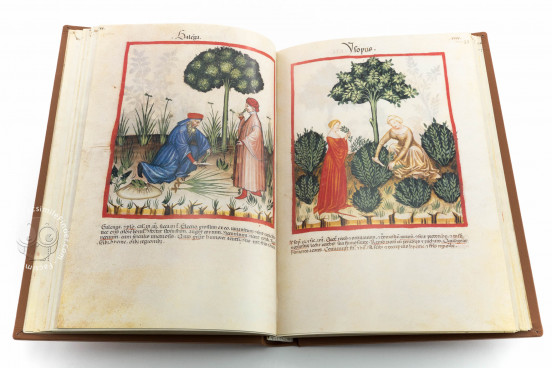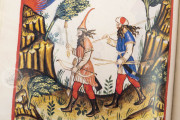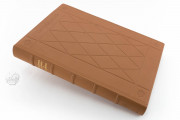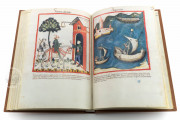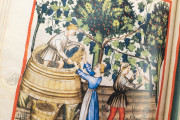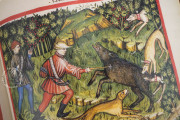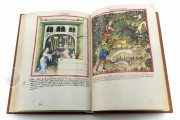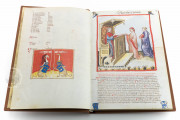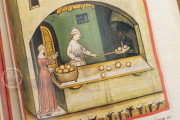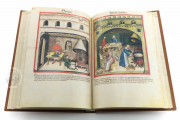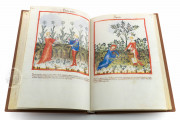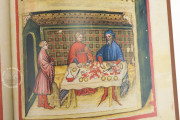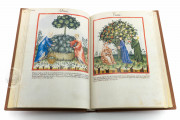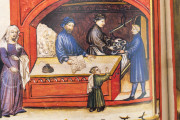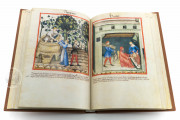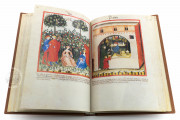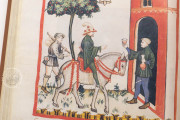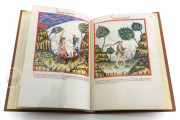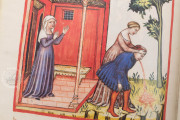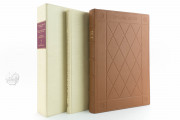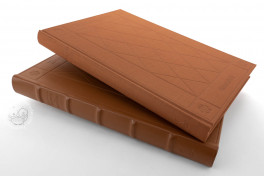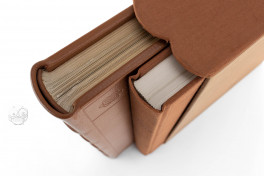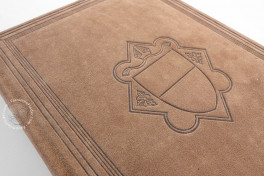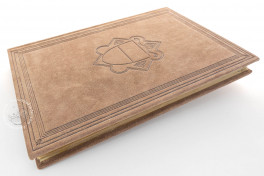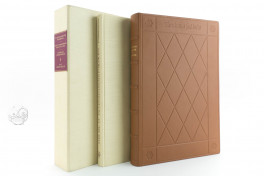The Tacuinum Sanitatis in Medicina ("Overview of medicine in tabular form") is among the most beautifully and richly decorated manuscripts in the Austrian National Library. This lavishly pictured handbook of medicine was conceived for a lay public, in particular for a lady of the upper aristocracy or of a rich patrician family who was able to afford, and read, such a costly "reference work" on household management as well as on topics of health and cure.
This type of book goes back to an Arab source written by the physician Ibn Botlan under the title of Taqwim Es-Sihha. The Arab art and practice of healing decisively influenced occidental curing methods and enjoyed a great reputation. The Latin translation, which made the codex accessible to the educated of the medieval western world, was widely known from the large number of surviving manuscripts.
Although at first the famous work was only comprised of synoptic tables without any illustration, it was later richly furnished with pictures, starting from the 14th century, and the text was resumed in captions inserted below each individual image. The Tacuinum presented here is among the oldest and undoubtedly the finest examples of its kind, displaying in 206 coloured full-page miniatures all that the 11th century – when the original was written – considered important with regard to human health and well-being.
A Testimony to Famous Oriental Curing
Tacuinum is an Arab word that remained untranslated but was given a Latin ending. As the work was translated from Arabic into Latin and had spread throughout Italy, the term tacuinum was integrated into the Italian language. In Italian, the term taccuino today still means notebook.
The then highly celebrated physician Elbochasim de Baldach (Ibn Botlan) wrote the Tacuinum in the 11th century, among several other medical works, and acquired great fame. In the 13th century, this work consisting of synoptic tables without illustrations was probably translated into Latin at the court of Manfred of Sicily, which made it a long-lasting influence on western medicine.
A Sumptuous Monument to Book Illumination
The codex is not only important for physicians and pharmacists interested in history but also because of its illustration with over 200 miniatures, and as an object of extensive study for the bibliophile public and researchers alike. In addition, its illustrations display an evocative image of old Italian culture as well as many aspects of daily life, thus constituting a rich source for experts in cultural history.
The Tacuinum must have been commissioned and made in Verona towards the end of the 14th century, judging from the coat of arms of the Cerruti family on fol. 3v. It is the common work of two painters in a surprisingly naturalistic style. They chose very strong colours which lend the miniatures enchanting freshness and vivacity.
A Medical Picture Book
The 206 full-page miniatures show numerous plants and animals, drugs and food, as well as winds, seasons and other environmental phenomena. The book describes their effect on the human organism according to classical medicine tuition. A text below each picture describes both the benefits and shortfalls of the object depicted.
The Tacuinum thus constitutes a medical picture book derived from the classical herbals tradition. The combination of pictures and relatively extensive explanatory text gives rise to a new type of book, which in terms of contents is closely related to Arab manuscripts, while its formal concept betrays the old western tradition.
The particularity of the illustrations resides in the fact that the individual objects are not represented alone, but, as in the text, are centered on the human being. Man is shown dealing with certain plants, animals, and other things. Based on the love of detail from everyday life, the naturalistic genre scenes with their rich stock of utensils demonstrate the lifestyle and the living conditions of citizens in a late medieval Italian city.
In addition to its great importance for the history of civilization, the Tacuinum is fascinating contemporary readers as it provides an opportunity to compare modern natural cures and healthy living practices with those used nearly 600 years ago.
We have 3 facsimiles of the manuscript "Cerruti Tacuinum Sanitatis":
- Tacuinum Sanitatis in Medicina facsimile edition published by Salerno Editrice, 1986
- Códice de Cerruti facsimile edition published by Editorial Casariego, 1987
- Das Tacuinum Sanitatis in Medicina facsimile edition published by Akademische Druck- u. Verlagsanstalt (ADEVA), 1966-1986

